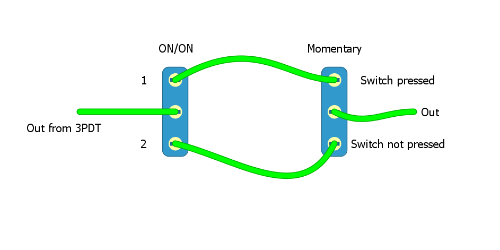Stutter
|
This post was updated on .
I remember seeing that a momentary "killswitch" is all you need to create a stutter effect, right?
I wanna add that to a pedal and I was thinking something like this:  A Spdt On/On toggle switch and a Spdt momentary switch. When the switch is in position "1" you get sound only when pressing the momentary. When the switch is in "2" you get no sound when pressing the momentary. Is that right? Won't the amp "pop" when you kill the sound? I will test, but I thought I'd share the idea as well. :) |
|
Yes, in principle that will do what you want, and yes, it will probably pop, but sometimes you get lucky. Any very small shift in DC offset will cause a pop. Even with no DC offset, switching a signal that is not crossing zero at the time will cause a click.
It's more common to perform the mute by connecting the signal to ground rather than simply disconnecting it. There are several ways to do it. Look here and on google for some ideas. But be careful if you connect the signal to ground, as some active components (TL07x, for example) will let the magic smoke out if you connect their outputs to ground for more than a second or two, so you may kill the previous pedal in your chain in some circumstances. But the signal grounding method will often pop as well. There is no passive way of implementing a killswitch that won't pop in at least some cases. Which cases? It's hard to predict. With two identical builds, one might pop while the other doesn't. Connected to different rigs, their behavior could change. But it doesn't hurt to try it out (especially on a breadboard). One of the passive approaches may perform adequately for your purposes. Lots of people use them. Lots of them complain about pops, but some people say they've never had a problem. For reliable non-popping killswitches, you can use jfet switching similar to the Ibanez and Boss bypass method. Look here for an implementation that you can adapt to your approach. The jfet circuit slows the switching down just enough to sound instantaneous without actually being instantaneous. Done correctly, it will eliminate both the DC pop and the AC click. You may need to experiment with component values on the breadboard to get it exactly right. This approach might be overkill, but it will reliable, repeatable, and less dependent on luck. |
|
In reply to this post by Zanius
I'm not 100% sure but for a kill switch you should send the signal to ground to prevent pop. So instead of breaking in-to-out, you should send in to ground.
|
|
In reply to this post by induction
Ok, I'm gonna study these! thanx!
But I was thinking.... Everytime you press that 3pdt switching between bypass and effect, isn't it the same thing? I mean, if you wire a momentary 3pdt the usual way to a (e.g.) booster circuit with the volume all the way down, wouldn't you have a stutter effect? You could even control the "depth" of the stutter, and even give it a "height" in that case. 
But I guess little "clicks" would still be there and when used continiously they would be bad. |
|
Standard bypass switching and killswitching may be slightly different, depending on how you implement them. Bypass switching selects between two separate signals. Your method leaves the killswitch output floating in bypass, which can allow for DC offset to build up in some cases. Most of the signal-grounding styles of killswitch don't disconnect the signal in bypass, instead they ground it while connected. If an equivalent amount of DC is present in both the bypass signal and the effected signal you may get pops from either killswitch approach where you wouldn't get standard bypass pops.
Whether the result is the same as normal bypass in a pedal with the volume turned all the way down depends on how the volume is implemented in the pedal. (It's hard to make definitive statements without a schematic.) But if you want a depth control for your stutter, you don't need a whole a booster circuit. You can just put a volume control in the stutter path. Unless you absolutely require no pops or clicks at all, I'd recommend breadboarding some of the passive methods. See if you're happy with the easy approaches first, and then address the problems if necessary. |
|
Yeah, I'm not gonna build a booster in there, just thinking "writin-gly" :P
You make absolute sense induction, I will conduct experiments prior to building something, thanks for all the answers! If I ever have some results I will post. |
«
Return to Open Chat
|
1 view|%1 views
| Free forum by Nabble | Edit this page |

